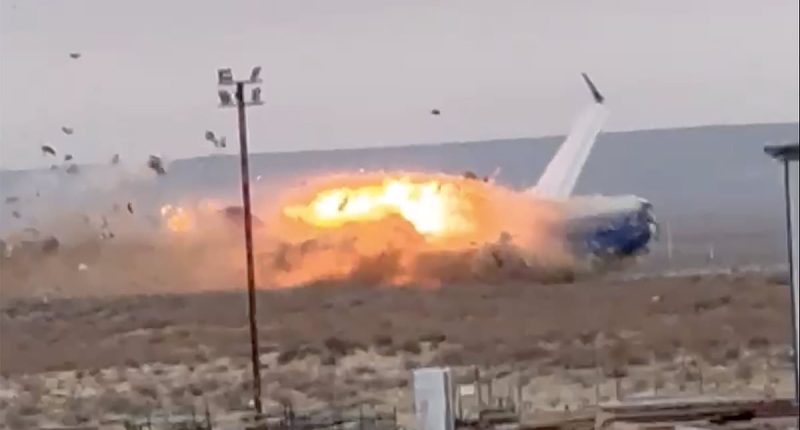Share this @internewscast.com
Sixty seven people were on board Azerbaijan Airlines flight J2-8243 when it crash landed just short of Aktau airport in Kazakhstan on Christmas Day.
Footage showed the passenger plane nose diving before slamming into the ground, erupting in a fireball and killing 38 people.
In the days that followed, claims emerged that the plane’s navigation systems had been compromised and the plane had been shot down, possibly confused with a Ukrainian projectile by ground artillery in Chechnya.
Local media cited government sources in suggesting jammers had ‘paralysed’ the plane’s communication systems. Russia tried to play down speculation.
A preliminary report later uncovered fragments from a Pantsir-S missile lodged in the plane. The crew had reported losing GPS aids due to jamming.
‘No one claims that it was done on purpose,’ one Azerbaijani source with knowledge of the report told Reuters. Putin did not say that Russia had shot down the plane, but did ultimately apologise for the ‘tragic incident’ inside Russian airspace.
Russia’s war with Ukraine rages on. The ceasefire between Iran and Israel broke down within hours. Armed conflicts continue across much of Africa, South America and Asia. Pax Americana is over. With this comes new threats to civilians.
Whether Chechen air defences shot down flight J2-8243 is yet to be established. But it is clear that signal jamming poses tangible challenges to safe air travel today.

The moment Flight J2-8243 crashed on Christmas Day, 2024, in Kazakhstan

The Embraer 190 aircraft was carrying 67 people. Only 29 survived

Flightradar24 tracks GPS interference. Green indicates low interference, red indicates high

Flight Radar data shows commercial flights avoiding Iran, Iraq and Syria amid regional conflict
The skies above Iran appear quiet on commercial flight trackers.
To the north, planes travel between Europe and Asia without interruption. To the south, there are always dozens of flights crossing through Saudi Arabia and Pakistan, carrying businesspeople and tourists to a meeting or a holiday or back to family abroad. Iran is decisively empty.
But its skies are not quiet. While Iranian, Iraqi and Israeli airspaces were closed this month, Iran’s conflict with Israel has seen fighter jets and missiles strike targets across the country, killing hundreds of people. Iran has responded in kind, firing missiles at Israel and devastating communities.
Modern warfare has started to evolve a solution. Israel knocked out swathes of Iran’s air defences when it launched its surprise attack on June 13. But jamming technology in the region offers another line of defence by confusing incoming projectiles.
FlightRadar24 data – shown above – shows ‘high’ GPS jamming interference around the Gulf, around Cyprus and the Sinai, south of the Black Sea, and south of the Caucasus mountain range.
Jamming is ‘a relatively uncomplicated technique’, explains Cambridge Radio Frequency Systems (CRFS) in a blog, ‘that involves producing a Radio Frequency signal strong enough to drown out the transmissions from GPS satellites’.
The affected system is then unable to place itself. GPS-dependent missiles and devices like drones and phones can be disrupted, veering off away from their target.
Relatedly, militaries can use ‘spoofing’ to tangle signals. While GPS jamming disrupts signals, spoofing confuses receivers about their location: amid Israel’s war against Hezbollah in Lebanon, an Uber driver in Beirut said his online map suddenly showed that he was in Gaza.
The devices confusing these signals do not discriminate. Civilian aircraft, search and rescue teams, mobile phone services, Air Traffic Control and, indeed, Uber drivers are just as susceptible to jamming and spoofing.
A pilot subjected to GPS jamming would quite quickly realise that they were not receiving data. With spoofing, they could be duped in travelling off course, exposing the plane and passengers to risk of collisions or venturing into hostile airspace.
FlightRadar24 has reported a ‘dramatic increase’ in such interference in the Middle East since the U.S. struck Israeli nuclear facilities on Sunday.

A service member of the 429th Achilles Separate Unmanned Aerial Systems Regiment stands next to FPV-drones at a position near the front line town of Kupiansk, amid Russia’s attack on Ukraine, in Kharkiv region, Ukraine June 23, 2025

GPS Jam data shows GPS interference in the region surrounding the Strait of Hormuz. Green indicates low (0-2%) interference; yellow indicates medium (2-10%); and red indicates high interference (10%)
Commercial ships, too, stand to be affected. Some 900 vessels in the Strait of Hormuz have suffered severe disruptions to their GPS systems in recent days as they navigate around the conflict.
‘There is usually no jamming in the Strait of Hormuz and now there is a lot,’ Ami Daniel, chief executive of Windward, told Reuters last week.
‘The culmination of all that is higher risk. It’s a hot area… if you don’t geolocate, there’s a bigger chance you’ll have an accident.’
Ships are required to indicate their location and are fitted with transmitters similar to GPS called an AIS, or Automatic Identification System, that send regular signals on location, speed and other data. Jamming disrupts these signals.
‘The problem these days is that most ships use digitised systems, so if your GPS is jammed, then you have no real form of navigating other than by the seat of your pants,’ Jim Scorer, secretary general of International Federation of Shipmasters’ Associations, told Reuters.
The Joint Maritime Information Center (JMIC) reported on Monday that there was increased electronic interference in the region, particularly affecting Global Navigation Satellite Systems and believed to be originating from the Port of Bandar Abbas and in the Central Arabian Gulf.
Flights and ships have to adapt to account for this. There is a clear benefit to travelling through familiar and efficient routes with established protocols. But the risk of having radars jammed, or being shot down, is pushing airlines to seek alternate routes, potentially adding on hours of travel time and using more fuel to circumvent a warzone.
Airlines are aware of the problem. Ryanair said last year that the number of such incidents has risen significantly in recent years. A spokesperson told The Mirror that Ryanair aircraft do have multiple systems in place to identify aircraft location, including GPS.
‘If any of the location systems, such as GPS, are not functioning then the crew, as part of standard operating procedures, switch to one of the alternate systems.’
They said that there had been a ‘rise’ in intermittent GPS interference in recent years, which ‘has affected all airlines’.

Israel continued to pound Tehran on Monday after the U.S. strikes on Sunday

A Russian Pantsir-S1 self-propelled, medium-range surface-to-air missile and anti-aircraft artillery system. Fragments from a Pantsir-S missile were found in the Azerbaijan AIrlines plane
An article in Military + Aerospace Electronics last summer noted that pilots were being advised to turn off the plane’s GPS receiver and use alternative navigation methods in the event of spoofing.
But, it warned, ‘the spoofing has been so strong that it can even affect a plane’s inertial reference systems, corrupting onboard position calculations and forcing pilots to rely on air traffic control for assistance, potentially overwhelming controllers’.
The Aircraft Performance Group quantified the problem, reporting a 500 per cent increase in spoofing incidents in 2024 alone, which they said coincided with the summer months and increased conflict activities’.
OpsGroup, a global organization focused on international flight operations, polled 2,000 flight crew members and found that nearly 70 per cent assessed their concern about spoofing as being ‘very high’ or ‘extreme’.
At the time, the primary actors they identified carrying out GPD spoofing were military units targeting hostile drones and drone swarms in conflict zones, like Israel, Ukraine and Russia, military units acting on behalf of the state and disrupting shipping, and military units disturbing the flight path of other GPS-guided ammunition, missiles or vehicles.
Crew on commercial fights were concerned about veering off course, not being able to use GPS landing aids, having to fly across the ocean without GPS, and receiving false ground proximity warnings, which could result in a collision.
Map shift, impact on weather radar, false Enhanced Ground Proximity Warning System indications and spoofed Runway Awareness and Advisory Systems were among the effects judged as potentially carrying the risk of an accident.

A kitchen in an apartment in a damaged residential high-rise buildings following the Russian drone attack in Odesa on June 20, 2025

A Russian drone is shot down by Ukrainian air defences during a night strike on Kyiv on June 23, 2025
Jamming and spoofing helps warring parties defend against incoming threats at short notice, even when air defences may have been overcome.
While jamming is usually just an inconvenience for aviation, it does pose tangible threats to safe travel, blinding pilots to potentially hostile environments.
As conflicts around the world continue unabated, these technologies present new challenges for airlines to address to ensure the safety of passengers on board.









